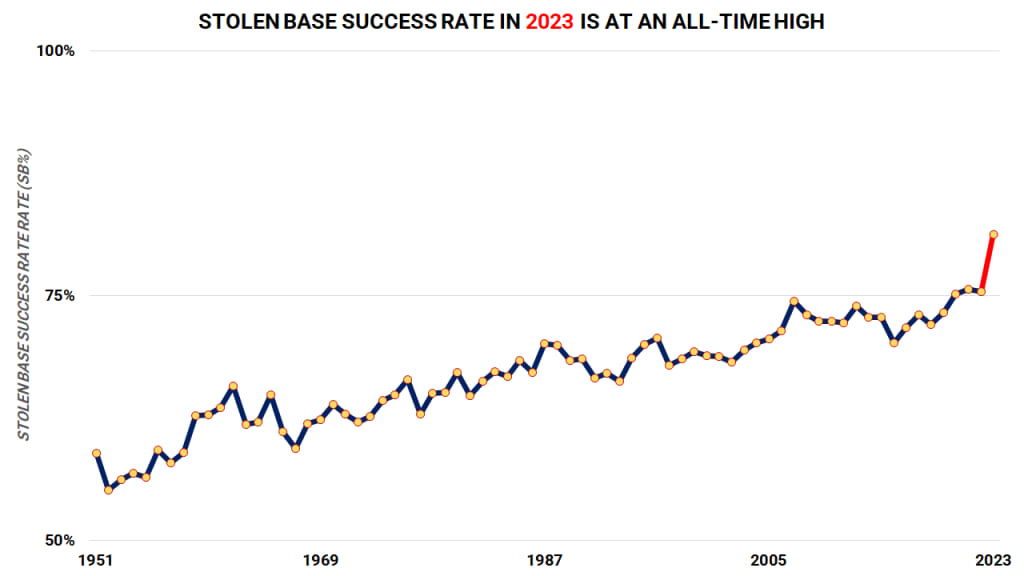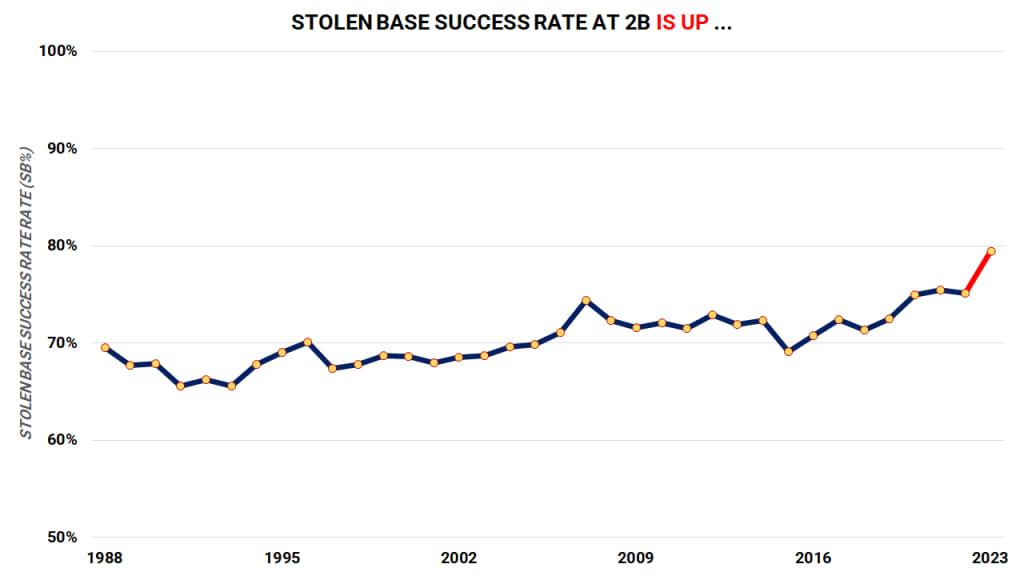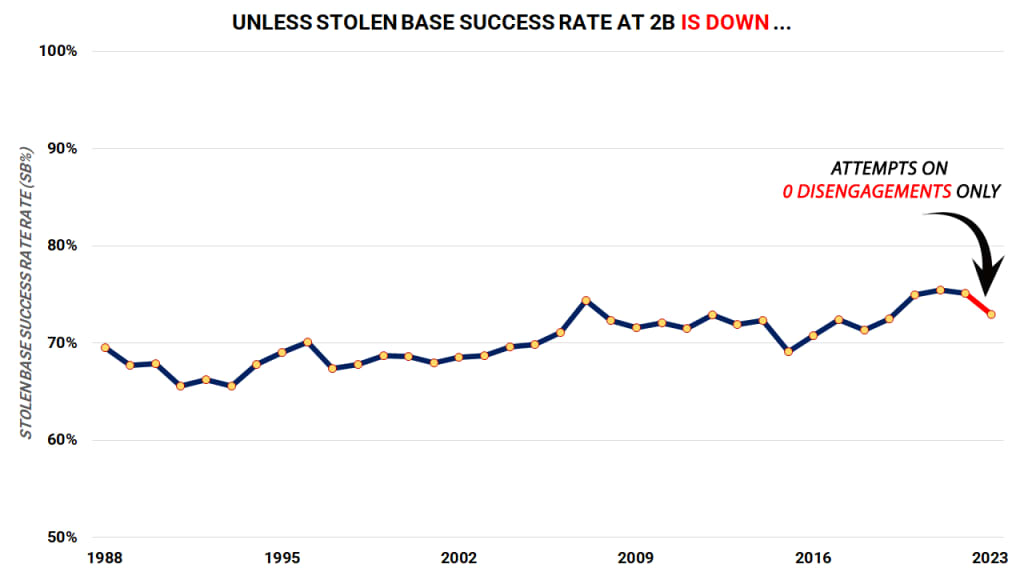If you like stolen bases, then you must absolutely love the new rules that have come to Major League Baseball in 2023. The new guidelines were specifically meant to encourage athleticism and action on the bases, and they’ve done exactly that.
But it’s not really about stolen-base attempts, at least not from a historical point of view.
While steal tries are indeed up over recent years, they don’t really stand out meaningfully historically. Through Sunday, we’ve seen 1.7 attempts per team game, which is higher than last year’s 1.4, yet similar to 2010, or 2000, or 1973, or 1937, admittedly cherry-picked years which also had similar rates of attempts per game. If the goal was to increase attempts over the recent lows of the 21st century, then mission accomplished. But 1.7 attempts per team game is more or less the same as the since-World-War-II average of ... 1.6.
Instead, the story is really about success rate. Of the first 241 steal attempts this season, 196 were successful, an 81% rate. If that sounds high, it is. It’s an all-time high. We're not seeing the most successful steals per game ever, because we're just not seeing the level of attempts we did decades ago. But when a steal is attempted, never in recorded baseball history has it been more likely to be a success.
We know the environment is different. We know the bases are slightly larger. We know the pitchers are limited in how often they can throw over to first base. So what’s actually happening here to cause the changes we’re seeing? It might not be what you think.
All data is up to date through Sunday's games.
1) Yes, success rate is up
… but it was already high!
If we say “it’s an all-time high,” we’d better show that. That 81% success rate this year would be the highest in baseball history (which we’re starting in 1951, when the caught stealing first began to be reliably tracked). The jump there is clear. We've never seen it above 76%, and now, in 2023, we're above 80%.

But while there’s an obvious leap over 2022, this jump somewhat obscures the fact that the second-best steal rate in baseball history was in '21, and the third-best was in '22, and the fourth-best was in '20, and really, each of the top 16 seasons have come since 2006. Stolen-base attempts had been down for a long time, yet steal success had been up anyway.
Why? As MLB.com’s Senior Data Analyst Tom Tango recently showed, for years before any of these new rules came into effect, teams were just getting smarter at picking their spots to steal, meaning they were getting better and better at avoiding the spots where they were less likely to succeed. "In 2016," Tango wrote, "runners had an expected SB% of 75%+ almost half the time, while they had an expected SB% under 60% over one-quarter of the time. Runners were far too aggressive. But over the years, runners are getting smarter. And in 2022, they were at their smartest."
So the new rules have had an effect, to be sure. But that said, at least part of the trend was already in motion.
2) Steals are up at second base, kind of
But it really, really matters when.
Let’s focus just on steals at second base. The success rate is up, though probably not in a way that’s easily noticeable to the naked eye. Is 79% higher than 75%? Sure. Could you have said there are plenty more successful steals at second if you didn’t have that number handy? Maybe not. It’s all of one extra successful steal every 25 attempts.

But there’s a new wrinkle this year, and it’s the term disengagement.
A “disengagement,” in baseball parlance, means either a step-off or a pickoff attempt with a runner on base. Pitchers can use it either to reset the pitch timer or try to nab a runner, but whatever they’re doing, they can only freely do it twice. If they try it a third time in a plate appearance, it comes with extra risk: Successfully get the runner out, or suffer the consequences of a balk. Pickoffs have mattered, even when they didn’t lead to an out; in 2015, Baseball Prospectus’s Russell Carleton estimated that a pickoff throw would decrease the success rate of an ensuing stolen-base attempt by 12 percentage points.
So let’s take that same chart above, and look only at steal attempts on zero disengagements. Guess what? Steal success is actually down.

If that’s true, then it must also be true that success rate after one or two disengagements must be higher than they are on zero, and it really, really is. It is essentially the entirety of the uptick in stolen-base successes.
Stolen-base success rate, 2023
- On 0 disengagements: 73%
- On 1 disengagement: 81%
- On 2 disengagements: 100% (that’s a mere 4-for-4)
All of which seems to mean that disengagements are valuable currency, and if so, drawing them might be a skill. It might be too early to say that some teams are prioritizing this where others are not -- surely this has more than a little to do with the identity of the runners on base and how often a team even gets on base -- but when you see the Guardians, Astros and Dodgers at the top of this list, maybe it’s not too early.
Batting teams to have drawn most disengagements w/ runner on
- 35 -- Guardians
- 32 -- Astros
- 25 -- Dodgers / Blue Jays
- [fewest: Rockies, 3]
Cleveland teammates Myles Straw (10) and Steven Kwan (9) are at the top of the individual leaderboard here, just ahead of Trea Turner (8).
3) Steals are wildly up at third base.
It took until Tuesday for a catcher to catch a runner trying to steal third!
Third base, however, is a different story entirely.
Until Arizona's Gabriel Moreno caught Milwaukee's Joey Wiemer trying to take third base on Tuesday night, there had been 28 listed stolen base attempts at third base, and exactly zero times that a catcher had prevented the runner from advancing. (Before Moreno, the only time a runner failed to reach third was on a play that didn't even require the services of the catcher -- it was a pickoff play by Washington’s Kyle Finnegan, a pitcher.)
This one is particularly interesting, because stolen-base rates at third base had been steady for years -- it was 77% last year, and 77% in 2008, and 77% from 2008-22, with minor deviations. But now, suddenly it’s 93%, including the Finnegan pickoff, or 97% without. What’s happening here? The view of Starling Marte’s stolen base here provides a clue:
Or the look of defeat on the face of J.T. Realmuto, universally regarded as baseball’s best baserunner-defeating catcher weapon, when he realized it wasn't even worth his effort to try to make a throw to catch Gleyber Torres.
Or how Ryan McMahon was 49 feet off of second base on his way to third when Domingo Tapia got around to making his pitch, taking a throw attempt entirely off the table.
Or the sheer length of time you'll need to watch this clip before you even realize that a runner was on second at all, because Eli Morgan certainly wasn't worrying about Conner Capel taking third -- even though Capel represented the game-winning run in the bottom of the ninth:
While McMahon’s example is a particularly egregious one, each and every one of the steals of third so far this year have had a lead distance (at the time of pitch release) of at least 26 feet, with most being over 30, and the average being 33 feet. It’s nearly two feet more than what it was on 2022’s attempts of third base, and if two feet doesn’t sound like much, realize that two feet was also the difference between the average lead distance (at time of pitch release) between a successful steal (32 feet) and a failed one (30 feet).
That, it seems to make clear, is a lot more about how pitchers are handling the new rules, and a lot less about the larger bases subtracting a few inches between the bags. Which also means that it's early, and that eventually pitchers will adjust, and at some point -- probably -- some catcher is going to throw out some runner stealing third base.
So how did Moreno do it? It helps that he got the ball down to third in a lightning-quick 1.46 seconds, but it's also that Wiemer, who had just stolen second base off Moreno and pitcher Merrill Kelly, had a secondary lead of only 26 feet when the pitch was released, on the very low end of the lead distances we just talked about. It was never going to be a 100% success rate at third all year, of course. But if pitchers can't help out their catchers a little more, it might be a much easier time stealing third than we've seen in years -- or, perhaps, ever.
